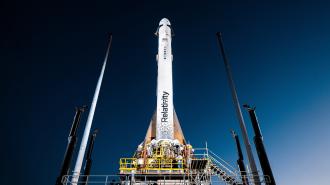California startup Relativity Space has just launched the world’s first 3D-printed rocket — and while the mission didn’t go exactly as planned, it did put the company a little closer to establishing itself as a major new player in the world of aerospace.
The launch: After scrubbing two previous attempts at liftoff, Relativity finally launched its 3D-printed rocket — called Terran 1 — from Cape Canaveral Space Force Station in Florida at 11:25 p.m. ET on March 22.
About 80 seconds later, the 110-foot-tall rocket successfully made it through Max-Q — the stage at which it would be under the maximum stress — and three minutes after liftoff, the rocket’s first stage separated from the second.
That’s where things stopped going as planned. The engines on the second stage were supposed to ignite, but an anomaly prevented full ignition, and instead of being propelled into orbit, the rocket fell back down to Earth early, landing in the Atlantic Ocean.
Relativity can build a rocket in 60 days, with fewer than 1,000 parts.
The reaction: No aerospace company has successfully reached orbit on its first attempt, and Relativity knew the chances of a 100% successful launch were slim — it named the mission “Good Luck, Have Fun” as a nod to the very real possibility of failure.
Still, the fact that the rocket made it through Max-Q is a huge win for the company, as its entire business model is built around the idea that 3D printing is a more efficient way to build rockets — instead of spending months or even years constructing a rocket from tens of thousands of parts like other companies, it can build one in just 60 days, using fewer than 1,000 components.

If Terran 1 — which is 85% 3D-printed, by mass — wasn’t able to withstand the stress of flight, it might have called that entire model into question.
“We successfully made it through Max-Q, the highest stress state on our printed structures,” tweeted Relativity after the launch. “This is the biggest proof point for our novel additive manufacturing approach.”
The other big deal: Aside from being the first to launch a primarily 3D-printed rocket, Relativity is now also the first to fly a rocket fueled by methane — which could be huge for the future of spaceflight with any type of rocket.
Relativity’s mission “from day one” has been to build an industrial base on Mars.
Compared to the standard rocket fuel — kerosene — methane is cheaper and more efficient. It also burns cleaner, which makes refurbishing reusable rockets easier. Relativity has already developed one of those, Terran R, and plans to debut the reusable rocket with a mission to Mars as soon as next year.
CEO Tim Ellis has also said Relativity’s mission “from day one” has been to build an industrial base on Mars — methane could be made on the Red Planet, meaning the fuel for return trips to Earth could potentially be created on site.
Looking ahead: Now that Relativity has launched its first 3D-printed rocket, the next step is seeing what it can learn from the flight data to ensure the next Terran 1 launch does reach orbit.
After that will come the first Terran R launch, and if that goes according to plan, Relativity will be already be thinking about Mars.
“3D printing with AI and robotics [are] how things are going to be built on another planet,” Ellis told CNN. “I’m really long-term bullish.”
We’d love to hear from you! If you have a comment about this article or if you have a tip for a future Freethink story, please email us at [email protected].






